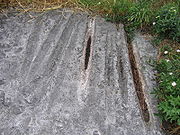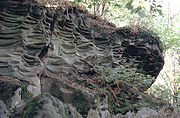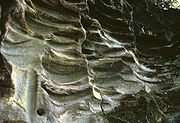
Grooves (archaeology)
Encyclopedia



Gotland
Gotland is a county, province, municipality and diocese of Sweden; it is Sweden's largest island and the largest island in the Baltic Sea. At 3,140 square kilometers in area, the region makes up less than one percent of Sweden's total land area...
. In Sweden, there are also grooves in north-western Scania
Scania
Scania is the southernmost of the 25 traditional non-administrative provinces of Sweden, constituting a peninsula on the southern tip of the Scandinavian peninsula, and some adjacent islands. The modern administrative subdivision Skåne County is almost, but not totally, congruent with the...
and Halland
Halland
' is one of the traditional provinces of Sweden , on the western coast of Sweden. It borders Västergötland, Småland, Scania and the sea of Kattegat.-Administration:...
, but they have also been found in Tavastia
Tavastia (historical province)
Tavastia, Tavastland or Häme, Russian Emi or Yemi, is a historical province in the south of Finland. It borders Finland Proper, Satakunta, Ostrobothnia, Savonia and Uusimaa.- Administration :...
in Finland
Finland
Finland , officially the Republic of Finland, is a Nordic country situated in the Fennoscandian region of Northern Europe. It is bordered by Sweden in the west, Norway in the north and Russia in the east, while Estonia lies to its south across the Gulf of Finland.Around 5.4 million people reside...
and in Luxembourg
Luxembourg
Luxembourg , officially the Grand Duchy of Luxembourg , is a landlocked country in western Europe, bordered by Belgium, France, and Germany. It has two principal regions: the Oesling in the North as part of the Ardennes massif, and the Gutland in the south...
. There is no consensus as to why they were created, but it has been suggested that they were made for sharpening swords, while others believe that they were used for astronomical observations
Archaeoastronomy
Archaeoastronomy is the study of how people in the past "have understood the phenomena in the sky how they used phenomena in the sky and what role the sky played in their cultures." Clive Ruggles argues it is misleading to consider archaeoastronomy to be the study of ancient astronomy, as modern...
.
Gotland
3,600 grooves have been discovered on Gotland , of which 700 are in the bedrock of limestoneLimestone
Limestone is a sedimentary rock composed largely of the minerals calcite and aragonite, which are different crystal forms of calcium carbonate . Many limestones are composed from skeletal fragments of marine organisms such as coral or foraminifera....
, while the remainder is on c. 800 stones. The grooves are about 50-100 cm long and about 10 cm deep and 10 cm wide.
They began to attract scholarly attention in the 1850s. In the beginning they were called "sharpening stones", but later they received the name "sword sharpening stones". After some time, newspapers and scholarly publications began to dispute this since the shape of the grooves made them unfit for sharpening swords. Another reason was the fact that by 1933, more than 500 areas of grooves had been identified on Gotland. They were evenly distributed across the island. It was also noted that they ran in different directions and often crossed each other. There are also picture stone
Picture stone
A picture stone, image stone or figure stone is an ornate slab of stone, usually limestone, which was raised in Germanic Iron Age or Viking Age Scandinavia, and in the greatest number on Gotland. More than four hundred picture stones are known today. All of the stones were probably erected as...
s with such grooves which suggests that at least some of them were made during the Viking Age
Viking Age
Viking Age is the term for the period in European history, especially Northern European and Scandinavian history, spanning the late 8th to 11th centuries. Scandinavian Vikings explored Europe by its oceans and rivers through trade and warfare. The Vikings also reached Iceland, Greenland,...
.
During the 1970s, it was suggested that the grooves had been used for astronomical purposes. Priests would have marked the position of the moon at certain dates every 19 years. A problem with the hypothesis was the fact that only very few grooves had been selected to prove the theory.
It has been shown that the grooves on Gotland are not randomly orientated but instead has a large concentration in the east-west direction. And the whole pattern is strongly symmetric around that direction. It has also been shown that the two different groups of grooves, those in the bedrock and those in stones with a large degree of probability has the same variation in directions.
Gantofta
Gantofta is situated 14 km south of HelsingborgHelsingborg
Helsingborg is a city and the seat of Helsingborg Municipality, Skåne County, Sweden with 97,122 inhabitants in 2010. Helsingborg is the centre of an area in the Øresund region of about 320,000 inhabitants in north-west Scania, and is Sweden's closest point to Denmark, with the Danish city...
and at the location a face of sandstone rock is engraved with thousands of grooves. So far no explanation for their making has been accepted as the plausible explanation. The positions of the grooves suggest that they could have been made with movable wheel constructions. Local tradition on the other hand says they were made by forming the whetting stones, used for whetting scythes by hand.

